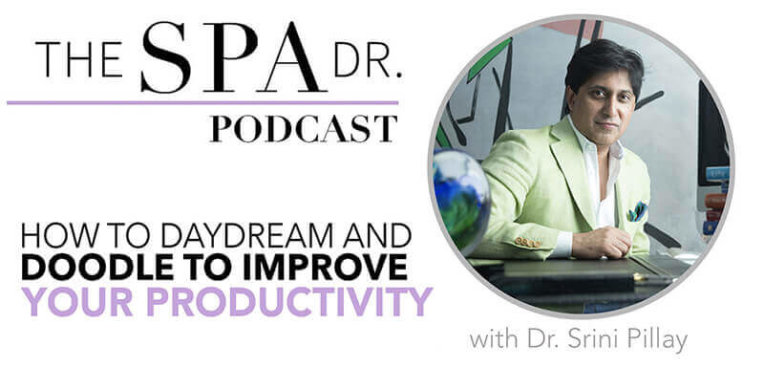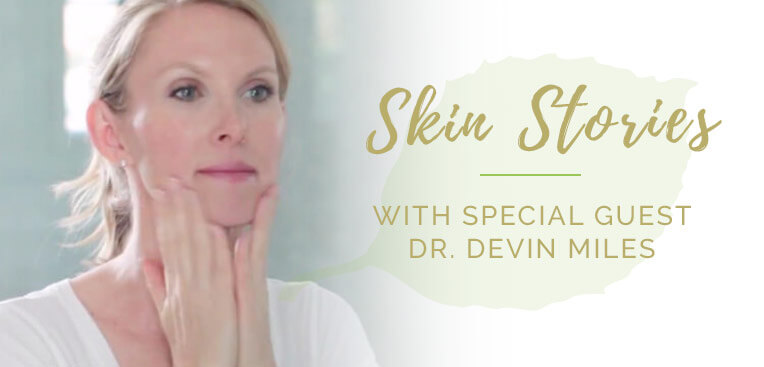Have you ever wondered why you’re tempted to doodle, daydream or fidget? My guest on today’s podcast explains why and how these actually can help your productivity.
My guest is Dr. Srini Pillay, a Harvard-trained psychiatrist who is the former Director of the Outpatient Anxiety Disorders Program at McLean Hospital. After graduating as the top medical student in South Africa, he graduated from Harvard as the top award-winner during his psychiatric residency. After seventeen years of brain-imaging research at McLean Hospital, he is now widely sought out by the media as a mainstream psychiatry expert who can apply brain science to everyday psychological challenges to help deal with psychiatric issues especially as they relate to stress and anxiety. He is also well known in the self-development space. He has been featured on Oprah radio, CNN, Fox, The Boston Globe, the New York Times, and NPR.
Apart from his clinical practice, Srini also runs a world-renowned startup called NeuroBusiness Group that helps leaders apply brain science to further their personal and business goals. Current and past clients include The World Bank, IMF, UN, Coca-Cola, Pepsico, Lockheed Martin, Prudential and top tier consulting companies. As a doctor, musician, poet and consultant to biotechnology-based investment firms, Srini’s approach to psychological challenges is biopsychosocial, research-based but informed mostly by his 25 years of clinical experience as a doctor. He was invited to the “Disasters and The World” group at a psychiatric think tank called “Group for Advancement of Psychiatry.” His current projects also involve intense work at the psychology and technology interface as well. Dr. Srini’s new book is “Tinker, Dabble, Doodle, Try: Unlock the Power of an Unfocused Mind” (Ballantine Books, 2017).
In today’s interview Dr. Srini explains how to be more productive and reduce stress using techniques that have been looked down upon such as doodling, daydreaming and taking naps. He shares some unconventional techniques and the research behind it that I think you’ll really enjoy.
So here is the interview with Dr. Srini…
If you have not done so already, I highly recommend that you get your customized skin profile at here. It’s free and based upon your answers, it will give you great tips for glowing skin and vibrant health. Also don’t miss out on all of the latest tips to get glowing skin and vibrant health, be sure to follow me on Facebook, Pinterest and Twitter. And join the conversation!
Thank you, and we’ll see you next time on The Spa Dr. Podcast.
Click here to order Dr. Srini’s new book Tinker Dabble Doodle Try: Unlock the Power of an Unfocused Mind and get exclusive free bonuses.
TRANSCRIPTION
Trevor: Hi there, I’m Dr. Trevor Cates. Welcome to The Spa Dr. podcast. Have you ever wondered why you’re tempted to doodle, daydream, or fidget? My guest on today’s podcast explains why we do this and how these actually can help you be more productive. My guest is Dr. Srini Pillay, a Harvard trained psychiatrist who is a former Director of the Outpatient Anxiety Disorders program at McLean Hospital.
After graduating as a top medical student in South Africa, he graduated from Harvard as the top award winner during his psychiatric residency. After 17 years of brain imaging research at McLean Hospital, he is now widely sought after by the media as a mainstream psychiatrist expert who can apply brain science to everyday psychological challenges to help deal with psychiatric issues especially as they relate to stress and anxiety.
He is also well known in the self development space. He’s been featured on Oprah Radio, CNN, Fox, the Boston Globe, The New York Times, and NPR. Dr. Srini’s new book is ‘Tinker Dabble Doodle Try: Unlock the Power of an Unfocused Mind’. In today’s interview, Dr. Srini explains how to be more productive and reduce stress using techniques that have been looked down upon such as doodling, daydreaming, and taking naps. He shares some unconventional techniques and the research behind it that I think you’ll really enjoy. Here is the interview with Dr. Srini. Srini, it’s so great to have you on my podcast.
Srini: I’m super psyched to be here. Thank you so much for having me.
Trevor: That’s great. Srini, you are a psychiatrist. There’s so much more to psychiatry than prescription medications. I think a lot of times, people are quick to turn to prescription medications, antidepressants and those sorts of medications. There is a lot we can do to help relieve stress and improve our productivity and get the most out of our lives without first resorting to these medications, right? Let’s talk about, let’s start with productivity. There’s a lot of talk about focus, like staying focused. You talk about unfocus. What does that mean?
Srini: I can imagine how when people say unfocused, most people’s first reaction is, “I’ve got enough of that because I’m distracted most of the day.” I think that to a large extent, productivity is helpful when it comes to … I mean focus is helpful when it comes to being productive. On the other hand, focus circuits alone in the brain if you just use them all day will lead you to fatigue.
Most people’s productive days are focus, focus, focus and the amount of energy they have just goes down and down and down. By the end of the day, they’re completely fatigued. What we’re finding is that in the brain, focus and unfocused circuits need to work together. People do a decent job at the focus circuits, but they don’t realize that when they become distracted, it’s because they haven’t taken care of the unfocused circuits.
Now what we’re learning is that there are very specific ways in which you can start to take care of these unfocused circuits so that you can reenergize your brain. My book ‘Tinker Dabble Doodle Try’ is actually about wanting to just have people rethink the way in which they’re structuring their days and also help them understand the science behind why this matters.
I think it turns the whole subject of productivity on its head because people feel like you’ve got to really stay focused, but there are a lot of things that I think they miss in the process. For example, if you say “I am focused”, sure, the one part of that is focused, but what about the ‘I’ part? How much of yourself do you bring to your day? How much of yourself do you bring to every engagement at any particular time of day?
I would say that for most people, it’s a certain amount of self. By that, I literally mean self circuits that are activating in the brain in the morning before lunch. After lunch, there’s not that much of yourself that you can bring to the table. A lot of people feel tired by the time they’re at 3:00. They bear with whatever they’ve got to get tasks done.
One of the questions I’d like people to readdress is, is it really worth it doing work on a completely exhausted brain or do you think we should start taking care of our brains in different ways? Unfocus refers to not distraction, but a number of different techniques which I’m happy to tell you about ranging all the way from starting to think in terms of possibility rather than being stopped by walls that we meet in our lives to very interesting techniques like daydreaming.
There are certain kinds of daydreaming which are negative and certain kinds of daydreaming that are really good for you. Jerome Singer, for example, has researched this since the 1950s. What he found is that there are three basic types of daydreaming. There’s the daydreaming that you slip into, which is a little bit like falling off a cliff. There’s the daydreaming which is guilty dysphoric daydreaming. It’s like going to a party and having more to drink than you wanted to, a little bit disinhibited.
Maybe you said stuff you didn’t want to say, did stuff you didn’t want to do, and the next day all you can do is think about, “Oh my God, I can’t believe I did this.” That kind of daydreaming’s not that helpful, but there is a kind of daydreaming that’s called positive constructive daydreaming which Jerome Singer studied and found that it did a number of really cool things. It actually increases your creativity and it also does what we call ‘attention cycling’.
It recycles attention because it gives your focus circuits a break for awhile and then it activates your unfocused circuits. When people say, “Well, how can daydreaming be positive and constructive?” Well, a couple of different things. The research has basically shown that when you start positive constructive daydreaming, probably the best way to do this is set time aside for it, 15 minutes maybe after lunch or 15 minutes in the middle of your really tired afternoon, have some kind of wishful, playful imagery.
Imagine yourself on a yacht, imagine yourself running around in the woods, imagine yourself having a ton of money and just hanging out. Whatever it is you want, relationship, money, imagine that and imagine it be wishful. The first thing is to unplug your perception. We spend all of our days with our eyes on things. We’re always looking outside of ourselves.
I’ve always suspected as a psychiatrist that the biggest issue when it comes to people, their productivity, and even their greatness is that they spend very little time inside their own heads. They’re constantly absorbing stuff from the outside. If I say to anybody, “How much time do you spend going inside yourself in a particular day?” Most people are not even aware that they have this amazing stuff that they can activate, which I’m happy to tell you about in a bit.
Just to complete the thought on positive constructive daydreaming, the first thing is to have wishful, playful imagery after you schedule it. The second thing is to close your eyes so you can just deliberately withdraw your eyes from looking outside and then you just mind wander for 10 to 15 minutes. It’s sort of the opposite of mindfulness. It’s mindlessness. What studies show is that this mindlessness activates an unfocused circuit called the default mode network in the brain, which is DMN.
If you want to remember this, think of it as the ‘Do Mostly Nothing’ network because that’s what we used to think it was. When you do this kind of thing, what studies also show is that it’s best done … you start by practicing and by closing your eyes, but it’s actually best done with low demanding activity and not no activity. The most ideal circumstance after you practice it the way I described it is to actually be knitting or gardening.
Trevor: You know what? That’s so interesting. In today’s world, we are so focused and so busy and distracted, if we’re not driving, if we’re not talking to somebody, if we’re not working, if we’re not looking at a computer screen, we’re looking in our phones, we’re on social media. There is no time for us to daydream anymore. I think it used to be easier for us to just check out. Now with all the stimuli around us, it’s so hard to do that. Now we have to schedule it.
Srini: Well, absolutely. Yesterday I was delivering a talk in Cleveland. I was actually, one of the people in the audience said, “I found a whole bunch of stuff where I was doodling and this was when I was at college. It suddenly struck me I actually was much smarter at college than I am now. At college, I went for walks, I doodled, I took time off, I daydreamed. Now, I pack my day from end to end. If I’m lucky, maybe I’ll book a massage, but even that I’m rushing to the massage and then when I leave the massage, I’m sort of in another world. There isn’t this kind of flow. I realized that it’s actually dumbed me down.”
One of the things I said to her was, “Well, maybe you were smarter. A study has shown that if you take a group of people who doodle while they’re listening to a really boring message versus a group of people who don’t, their memory improves by 29%”, which is interesting. You would never think, and most people, most teachers shout at students when they’re doodling. They’re like, “Pay attention.” Not recognizing that when you doodle, it’s actually a way of bringing a certain kind of reign to your thoughts.
Your mind doesn’t just wander somewhere else while someone’s talking. It wanders off into something, but it’s also relaxed enough like a sponge to be able to absorb information. Just being stiffly attentive to something doesn’t necessarily guarantee that your brain’s going to pick up that attention. I feel like it’s these kind of counterintuitive things which we need to bring back into our lives.
Actually, there’s a more profound significance of it as well and I’ll tell you what it is. It was the most exciting finding when I was looking at the brain research behind this. I was thinking, “What’s going on in the brain when we’re unfocusing?”, whether we’re daydreaming or napping, which is also another way of doing this that’s pretty cool. 10 minutes of napping can actually improve clarity, whereas 90 minutes of napping improves creativity.
Part of what I was thinking was, “What goes on?” When you go look in these unfocused circuits, something very interesting happens metaphorically. You know how on a day-to-day basis we kind of know who we are? We’re like, “I’m male or female, this is my age, this is what I do, this is where I live, this is what I do for a living.” Focused attention, when you’re focused on something acts like a fork.
It picks up pieces of your identity and when it picks up pieces of your identity, it brings it into the moment so all the concrete things about you are known. When the unfocused circuits are activated, what we find is that basically an entire different set of silverware, metaphorically, is invited into the brain.
All of a sudden, you have spoons, neurons that pick up the delicious melange of flavors of your identity like the smell of your grandmother’s apple pie on a crisp fall day or the feeling that you felt on your first date when you feel in love with someone. Anything about yourself that’s subtle, the feeling you feel when you see roses. All of these things are parts of our identity that we usually leave aside from the rest of our day.
We have work identities and then we have date identities and we have party identities. When we’re trying to work, why wouldn’t we want all of ourselves to be there? The spoon essentially brings this delicious melange of flavors of intangibles to the table. In addition to that, you have these chopsticks where you start making connections across the brain.
All of a sudden, there are these parts of your brain that actually start getting activated by unfocus where connections that you would never make with a focused brain suddenly start to arise. In addition to that depending on your tide, you basically have something like a marrow spoon or a melon spoon that goes into nooks and crannies and picks up these other intangible things about you.
Now all of a sudden, you’ve gone from having an identity that’s defined by a fork which is concrete blocks of things to having a dish of yourself with this delicious melange of flavors, stuff that’s getting connected in the flavor, and you’re also getting these subtle little elements that ordinarily are not there as part of your identity. This is what motivates people. People who are productive are motivated because they can bring themselves to the table more fully and more wholly.
People who are not motivated no matter how hard you try to push yourself, if you are not present as much as you can be, it’s very hard to complete any task. For me, one of the most profound implications of unfocused is the ability to bring these intangibles to the table and why shouldn’t you? You live, you die, you do something in between. Why wouldn’t you want the subtle parts of yourself to be part of everything that you’re doing?
Trevor: That’s so true. In addition to doodling, what are some of the other things that are helpful? I’ve never been much of a doodler. I’ve seen other people do that. You know what was interesting, yesterday, my 18-year-old son was mentioning that he likes to move his hands a lot or move his feet a lot at school. He feels like it’s distracting and he wants to stop doing it, but now I’m listening to you thinking maybe there’s a reason why he needs to move like that.
Srini: Yeah. There’s a field in neuroscience called embodied cognition. Essentially what this means is that we usually think of ideas and thinking as being coded for in the brain, but as you know, someone who studies interactions across the body and if you know from people your skin is important, your gut is important, your brain is important. These are all connected.
In the same way, movement is actually very connected to thought and our bodies carry information about that movement. Studies have shown, for example, that walking actually does free your mind up in the way that you’re talking about it and increases your creativity and activates the unfocused network.
They’ve also shown that if you walk a straight and narrow path, so if you just go around in a square versus if you just walk in a zigzag and go into different directions, you’re much more likely to be creative. Your thoughts are much more likely to be creative if you go in this undefined direction. They’ve even done simple experiments like drawing something very sharp edged and doing something very fluid and that moving your hand in a fluid way actually increases your creativity, so I think you’re on to something.
I think that this kind of undefined-ness, which I think at our core, we’ve always suspected is a big part of who we are as humans. Nobody wants to go on a date with a robot. Nobody wants to spend all evening with someone who’s all perfect. Part of that is because there’s something beautiful and creative that emerges from someone who’s willing to be unfocused. I think that’s a really important piece of being alive and I think in terms of techniques, I think certainly physical movement is a big thing.
One of my favorites is something that I call ‘Psychological Halloweenism’. Psychological Halloweenism is a fun thing. It was based on a study that asked people, so one of the key tests we have for creativity is you ask people, “You’ve got one minute. Give me as many as you can for a brick.” If you’re creative, you’ll start with a house and then you’ll start thinking about all kinds of things, that fence and you start thinking about maybe it’d be useful for holding something down if it’s about to fly away.
The more creative you are, the more your thoughts flow. What they found was that if you put yourself in the personality of an eccentric poet, you are much more likely to solve many more creative problems than if you put yourself in the personality of a rigid librarian. Now of course, not all poets are eccentric and not all librarians are rigid, but in this experiment, they actually created these two conditions.
The people who were eccentric poets, they just embodied it. They were sitting back thinking, being in this kind of fluid mental state. It actually changes the way in which they think and the solutions they find. I’ve actually presented these at a couple of workshops recently and I got some really funny responses. There was one response, for example, where I delivered at a very conservative organization that was interested in climate change.
When I talked to them, I said, “Think of someone who doesn’t think like you.” One of the people called me to the table and said, “I’m having a hard time with this. I thought, well, who’s the opposite to me? I thought, well, probably Donald Trump. Then I thought, well, why don’t I come up with how Donald Trump would handle the situation on climate change?”
He started trying to mock it and so he said, “Probably what he would say is ‘Get the best people. Get the best people on climate change. Let’s see who the best people are.'” I said, “Who would the best people be?” He said, “People like Elon Musk.” I said, “Well, have you met with Elon Musk?” He said, “No.”
I said, “Well, that’s interesting. Maybe you can separate out your feelings for being so different from Donald Trump with the fact that people who are different from you can actually inform you about how you might think, and why wouldn’t you? You’re a world expert in climate change, Elon Musk is known for his interest in climate change. If you’re thinking about funding and spreading the word, he might be a useful person to actually turn to.”
There were other people who said things like, “When I use Psychological Halloweenism, I suddenly get outside myself and I start seeing that there were solutions I could never have seen because I’m stuck to my habits.” What unfocus does is it actually helps you become unstuck. It helps you suddenly realize the world as we see it is the world as we see it.
We bring all of our traumas, all of our negative stuff, all our positive stuff, everything that’s present. That’s our lives. Perception is shaped by who we are. If suddenly we decide we want to be Oprah or we decide, “I just want to be Tom Brady. I want to just think that there’s no obstacle in my way. I want to be Serena Williams.” Sort of like, “I want to reach the top.”
A lot of people don’t put themselves in that position because they’re afraid for a lot of reasons which maybe we’ll get to in this conversation. One of the things they’re afraid of is they feel like they’re acting. There’s a Polish psychiatrist who actually recommended a slightly different version of the Psychological Halloweenism which he called Positive Disintegration.
He basically said that gifted students and people he studied who have been very successful, when they go from one level to another, they almost always have to disintegrate to reintegrate. You can’t go with the same habits from one level to another. A lot of times we experience pain or psychological discomfort and we judge ourselves and we say we should go back to what we were doing because this hurts too much.
According to Dabrowski, he basically said this is the nature of change is that it involves disintegration. It is best resolved by asking yourself and he has another unfocused question because every day, we want to be ourselves, right? But what if you were a higher version of yourself according to you as defined by you?
When I asked myself that question, I thought, “There’s stuff that I could be doing that I’m really interested in that I’m not doing that could be more authentic. There’s other stuff I’m doing that’s kind of boring that I’m not easily bored, so I can make anything interesting.” I realized that because I’m a rationalizer, I should be aware of that, that actually there are things that I’d like to be doing.
I would ask anyone who’s listening, is there something in your life that you would consider as bringing you to a higher version of yourself? Really it could be anything. It could be anything from eating a certain kind of food you like to changing your job to really expressing something that you feel has been squelched over time.
The whole point is rather than just going on the straight and narrow path and zooming through life as if, “This is me every day. This is what I do. This is who I am. I’m going to do this. Bang my head against a wall.” Stop for a second, chill out, ask yourself, “What is this higher version of myself and how can I get there?”
I actually happen to think that this is a really important competency in the age of robots. Robots are going to probably replace more than 35% of our jobs. The one circuit that is very hard to replace is this default mode network. This is the network that creates love and empathy and compassion and creativity. My whole point is let’s develop the circuit so we remain relevant. For me, that’s a big piece of what this book is about and where it came from.
Trevor: That’s fantastic. What are some of the things that hold us back? What are those fears? You mentioned there are things that happen that block us from being able to do that.
Srini: There are a lot. I would say one of the things is fear of failure, which is intimately tied to fear of success. In the book, I describe the idea, the difference between SEM and SEO. I’m not talking about computers and the internet. SEM is self-esteem maintenance. That’s how most of us live every day. We just want to get through. SEO is self-esteem optimization. Self-esteem optimization is basically saying, “I want to optimize.”
Now just a little bit of interesting theory behind this. There’s a phenomenon known as repetition compulsion which Freud and a bunch of other people discovered initially while watching children. What they found was that … you can imagine a group of experimental psychologists taking truants’ behavior really seriously.
They’re looking at it and they’re like, “This behavior is really peculiar. I don’t understand this. Now the child is in a cot. Step number one I did not understand. They’re throwing the toy out. Why would you throw something that you love and that is yours out? Why would the human brain be wired to do such a weird thing?” Then they’re like, “Step number two’s even weirder. Then they cry about it. It’s not like anybody took the toy away. They threw the toy out, then they cried about it.”
Step number three is the mother brings the toy back. Step number four and so they get happy. Step number four is they throw the toy out again. They thought, “What could this indicate not just about children’s brains, but about the ways in which we are wired?” What one of the leading theories about human existence, and here, I really would want everybody to take this in because I think this organically is probably one of the most important pieces of what I’m sharing, is that we are wired to master disappointment and not to seek fulfillment.
Kids from an early age learn to get really good at crying, recover, crying, recover. If you watch your pattern over life, a lot of times you’ll see that there’s a similar cycle that when you’re a resilient person and you’ve made it through life, you might have had difficult financial circumstances and you finally made it.
You didn’t have a job or you lost your job and then you got it or you were alone and then all of a sudden, you were with someone or you didn’t have a child and you wanted a child and you had a child, you feel like, “Wow, that’s really great. I got over that.” Getting addicted to mastering disappointment keeps you from building fulfilling activities into your day.
When you asked what are some of the things that keep us back, it’s this habitual pattern. It’s habit hell of repetition compulsion that keeps you stuck in a place where you are proud of overcoming your obstacles, but you’re not saying, “Hey, why don’t I build a fulfilling activity into my day?” because somehow we feel guilty about that.
Trevor: We are trying to reprogram ourselves for a different way of thinking then and looking for what we really optimally want to be and spending some time each day looking at that. I think it’s so much time we spend worrying about things or say, “Oh my gosh, if only”, but not really seeing ourselves in a different state and so I love what you’re talking about. Srini, tell everyone about where they can find your book. I’m sure people are going to want to learn more about this because there’s so much more we could talk about. Tell us where we can find your book.
Srini: Thank you very much. I actually just got copies today, so this is the book. It’s on www.drsrinipillay.com. You can find it on Amazon, Barnes & Noble, any major retailer. I’d love for people to take a look at it. I’ve actually created a lot of cool stuff I think that goes along with it. There’s actually, if you get the book in a certain period of time, there’s actually a quick start which basically helps you reschedule your day.
I’ve actually created a little piece of software called The Tinker Table that is a calendar add-on. It basically forces you to relax. If you decide how many minutes you wanted to block off and how many days you wanted to block off and then you choose one of the tinker methods that we talked about ranging from meditation to possibility thinking to dabbling, doodling and you choose what you want and you say populate and it will block off where it finds 10 minute segments in your day.
I would love for people to get that. There’s lots of other stuff to help reorganize the brain, but I feel like it’s time for us to re-humanize. I think that it certainly would bring a lot of joy to me if people got the book, but I think it would bring even more joy to me if they got it and found that it had a profound impact on their lives.
Trevor: Absolutely. Thank you, Srini. Your information is so valuable and I’m excited to read your book as well. I will make sure that we have the link on my website too below your podcast so that people can go there if they’re listening and not able to write it down right away. We will have the link up there. Again, thank you, Srini, for coming on and sharing your information and best of luck with your book.
Srini: Thanks so much. It’s always lovely to be with you.
Trevor: I hope you enjoyed this interview today with Dr. Srini Pillay. To learn more about Dr. Srini, you can go to my website, thespadr.com/podcast. Go to the podcast page with this interview. You’ll find all the information about him there as well as the show notes, the transcriptions of the podcast, and while you’re there, I also invite you to join The Spa Dr. community and subscribe to the podcast on iTunes so you don’t miss any of our upcoming shows.
Also, if you haven’t done so already, I highly recommend that you take the skin quiz to find out your skin type and root causes behind them. It’s free, it takes just a few moments, and you get your own customized skin report. Just go to theskinquiz.com. Also join us on social media on Facebook, Pinterest, Twitter, Instagram, YouTube and join the conversation. Thank you and I’ll see you next time on The Spa Dr. podcast.








Reader Interactions